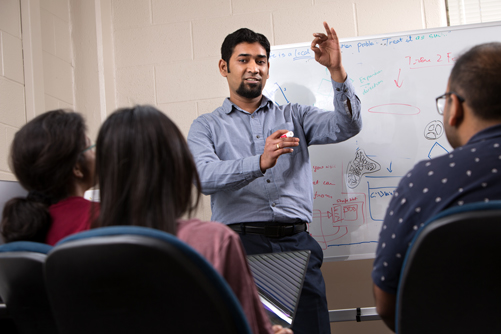A researcher with the Department of Mechanical Engineering at Texas A&M University is working to create the next generation of computer-aided tools for enabling conceptual design – an undertaking instrumental in catering to the ever-increasing demand for product innovation.
Dr. Vinayak, assistant professor of mechanical engineering, is developing “mixed-initiative” software interfaces that would allow human designers to collaborate seamlessly with the computer to design products that function. These software interfaces are intended to help many kinds of specialized professionals, from industrial designers and architects to prosthetic specialists, understand and take into account design constraints for a better end product.
 “Design is a key component of so many disciplines,” Vinayak said. “If you’re doing electronics, computer science, computer engineering, arts, architecture—anything—design is a common component. The designers in these cases are domain experts in their specific field who need to account for so many different constraints and needs that they may not even be aware of.”
“Design is a key component of so many disciplines,” Vinayak said. “If you’re doing electronics, computer science, computer engineering, arts, architecture—anything—design is a common component. The designers in these cases are domain experts in their specific field who need to account for so many different constraints and needs that they may not even be aware of.”
For example, in fitting an amputee with a new artificial limb a physician becomes an unwilling designer who, while knowing the medical constraints of the patient, is not entirely aware of the engineering aspects (the exact shape of the amputee’s limb, material selection and loads on the limb) affecting the design of the device. Making the device becomes a trial and error process for the doctor and the patient, often resulting in failed products.
“Our goal is to make software tools that help account for mechanical information such as stresses, materials and so on, while being able to present that information to the medical professional in a language that they best understand,” Vinayak said. “This greatly improves the favorability of the outcomes for both the medical professional as the designer and the patient as the customer.”
Another example is that of an architect who is designing the form and feel of a staircase without being completely aware of how to systematically incorporate the mechanics and kinematics of the staircase within its artistic elements. Vinayak hopes his mixed-initiative design approach will address this problem by providing designers with a computer system that participates in the design process as a partner, supplies missing information, questions the designer’s decisions and ultimately “talks” to them, working toward getting a useful and functional product.
While the research is currently in the fundamental stages, Vinayak is hopeful about the interdisciplinary benefits it may bring.
“As we move forward, design tools need to accommodate the experts who want to create complex functional products for their users as well as the end users who want to build useful things for themselves,” Vinayak said. “So we are doing this to empower the designer and the customer.”
Media contact: Brooke Amador, Communications Specialist, Mechanical Engineering